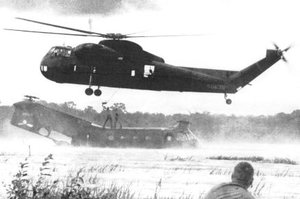Sikorsky CH-37 Mojave
|
|
| CH-37 Mojave | ||
|---|---|---|
 CH-37 Mojave attempting to lift a crashed CH-21 Shawnee. | ||
| Description | ||
| Role | Medium cargo helicopter | |
| Crew | 3 | |
| Dimensions | ||
| Length | 88 ft | |
| Rotor diameter | 72 ft 1 in | |
| Height | ||
| Weights | ||
| Empty | ||
| Loaded | ||
| Maximum take-off | 21,000 lb | 9,500 kg |
| Powerplant | ||
| Engines | 2 Pratt & Whitney R-2800-54 Double Wasp radials | |
| Power | 2100 hp each | 1566 kW each |
| Performance | ||
| Maximum speed | 131 mph | 211 km/h |
| Combat range | 247 mi | |
| Ferry range | ||
| Service ceiling | ||
| Rate of climb | ||
The Sikorsky S-56, called the CH-37 Mojave by the US Army and HR2S-1 by the US Marine Corps, was a large heavy-lift helicopter by the standards of the 1950s. It came into being as an assault transport for the USMC, with a capacity of 26 fully-equipped troops; the order was placed in 1951, the first prototype flew in 1953, and production deliveries began in July 1956 to Marine Corps Squadron HMX-1, sixty aircraft in total being produced.
The US Army evaluated the prototype in 1954 and ordered 94 examples as the CH-37A, the first being delivered also in summer 1956. All Marine and Army examples were delivered by mid-1960. Army examples were all upgraded to CH-37B status in the early 1960s, being given Lear auto-stabilization equipment and the ability to load and unload while hovering. In the 1962 unification of US military aircraft designations, USMC examples became CH-37C.
At the time of delivery, the CH-37 was the largest helicopter in the Western world, and it was Sikorsky's first twin-engined helicopter. Two Pratt & Whitney Double Wasps were mounted in outboard pods that also contained the retractable landing gear. This left the fuselage free for cargo, which could be loaded and unloaded through large clamshell doors in the nose. The single main rotor was five-bladed, and designed to function with one blade shot away in combat.
The CH-37 was one of the last heavy helicopters to use piston engines, which were larger, heavier and less powerful than the turboshafts subsequently employed. This accounted for the type's fairly short service life, all being withdrawn from service by the late 1960s, replaced in Army service by the CH-54 Tarhe.
Four CH-37Bs were deployed to Vietnam in 1963 to assist in the recovery of downed US aircraft. They were very successful at this role, recovering over $7.5 million dollars' worth of equipment, some of which was recovered from behind enemy lines.
Specifications
|
Lists of Aircraft | Aircraft manufacturers | Aircraft engines | Aircraft engine manufacturers Airports | Airlines | Air forces | Aircraft weapons | Missiles | Timeline of aviation |
